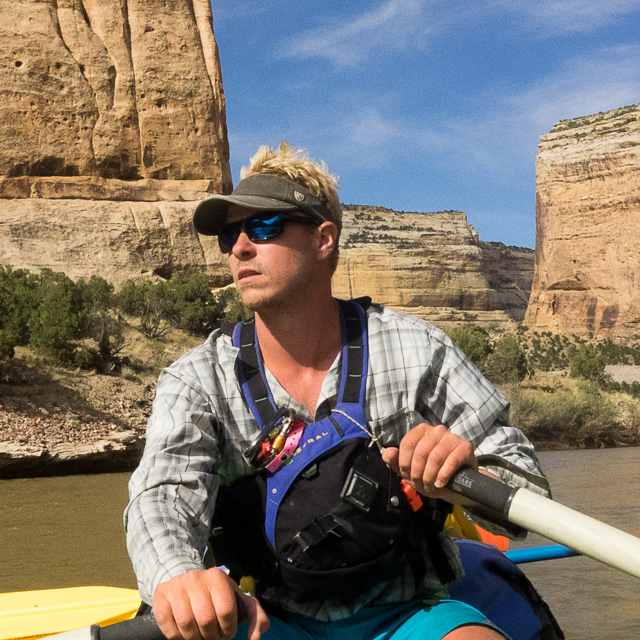Blog
stories • happenings • adventures
Plan B in Tennessee – Bikepacking Big South Fork Rec Area
“It’s smoky up this way, too,” I said, gazing out the jeep window.
Boberts and I were driving northeast, through one of those long, linear valleys the Appalachians are known for. Patches of smoke drifted over the ridge tops and spilled across rural farm fields. It was fall 2016—the weekend after the presidential election—and massive forest fires were finally contained around our originally-planned route through Nantahala and Chattahoochee National Forests. Even though the trails were re-opened, a hoot and hollerin’ ride through a clean-up zone seemed uncool, plus a respiratory nightmare.
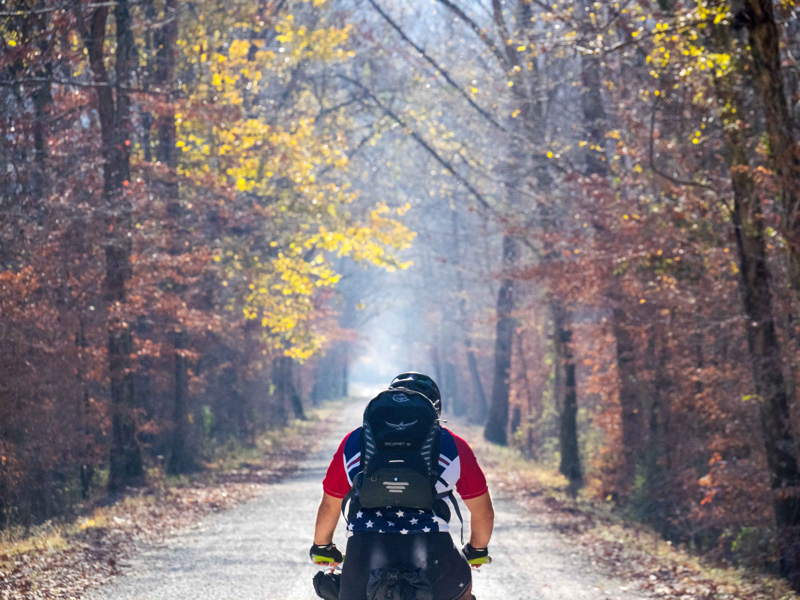
We’d scrambled to find a plan B. Boberts only had Friday off, while I was just passing through between projects. We needed a three-day ride, with moderate mileage and elevation—maybe 90 miles and 6000 feet of climbing—within a few hours’ drive of Chattanooga. Scanning the map, my eyes locked on Big South Fork Rec Area. A beautiful place, which I only knew from kayaking years before. An internet search revealed a slew of gravel roads and multi-use trails, plus river viewpoints and forested slopes that might still have some fall color. There was even a recently designated Epic ride.
I couldn’t find much online info about previous bikepacking. One guy in a forum said he was riding in with a sleeping bag to avoid campground fees—about ten bucks, about ten years ago. The guy was never heard from again… on this particular forum. Boberts and I had spent a month preparing for our first foray into cold-season bikepacking, and we were itching to go somewhere. I suggested, why not stick to our roving rider approach and explore. What could possibly go wrong?
“We’ll see,” said Boberts.
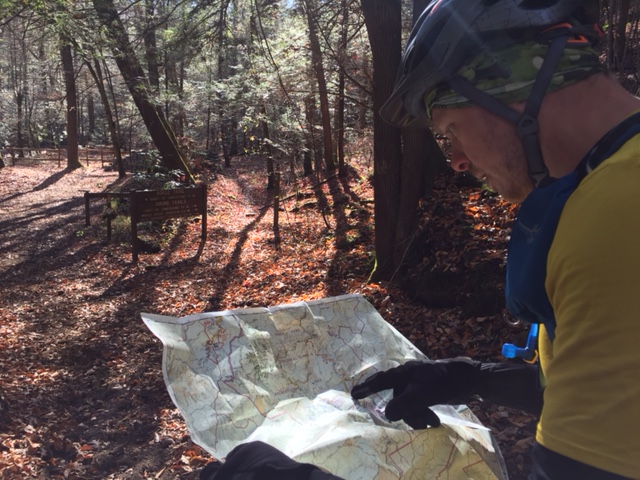
After stopping by Bandy Creek Visitor Center for info, we packed up and started around noon. The gravel Duncan Hollow Road led through fields and forests. The colors on the trees were, well…there were two: evergreen and brown. Sure, there were hints of crimson and pale orange. But, overall, it looked like the heat and drought had sent most leaves straight to brown and ground.
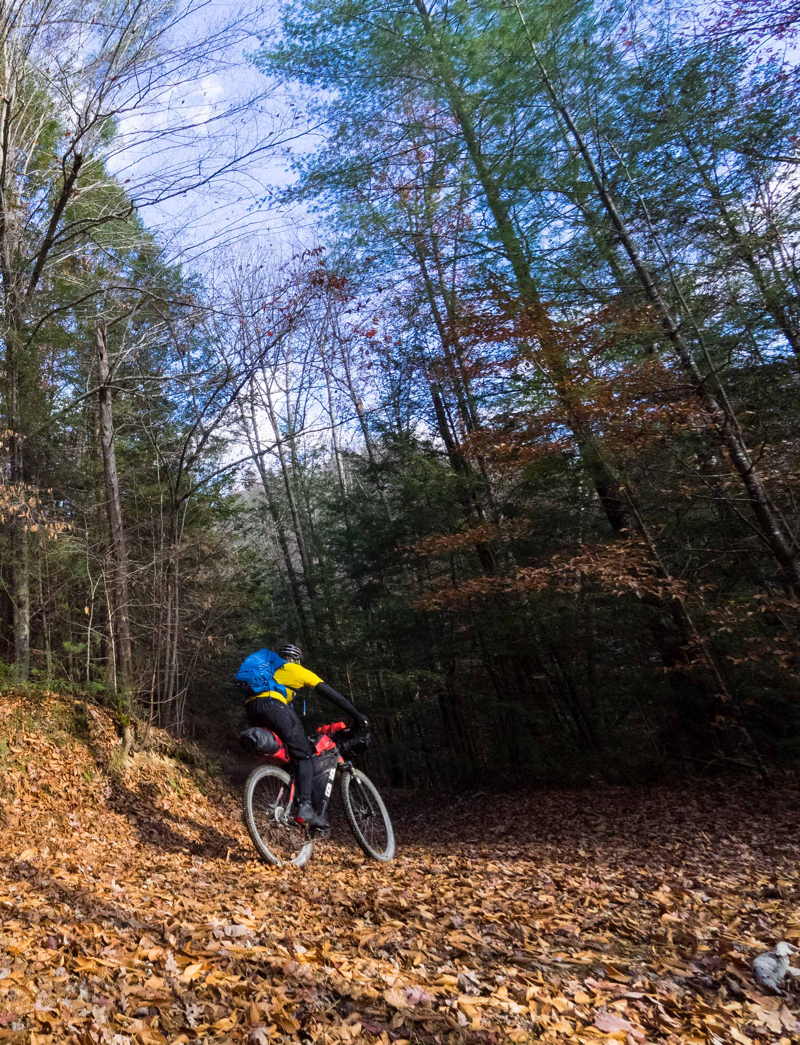
We shrugged this off and focused on the route, which soon dropped off the plateau down a ridiculously steep dirt trace that made our brake pads sing until singed. In a shady landing, midway to the bottomlands, we stopped to cool our bikes and warm our hands beside the rotors. Continuing, we forded a pair of creeks with bare feet, and soon we rode next to the Big South Fork of the Cumberland. The trail was as scenic and flat as we’d hoped, but some spots were just roots stripped of topsoil by previous high flows. Other sections were pocked by thousands of cobblestones churned up by horse hoofs. We rode when we could, but often walked.
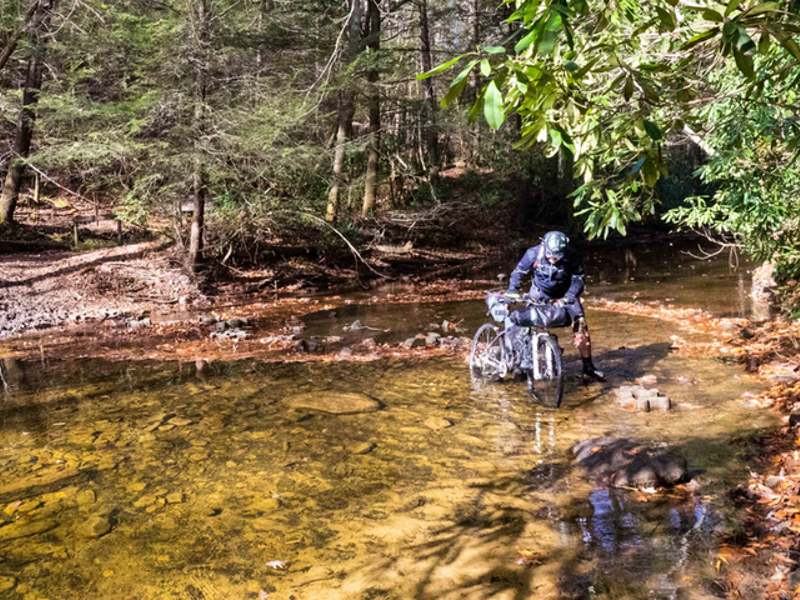
“Baby heads,” mused Boberts.
“Bowling balls,” I muttered.
We dismounted to chat with a friendly woman on horseback, the only person we saw that afternoon. But after she passed, we scowled at her horse—which left us a little present dropped onto the choppy trail in reply. When the riverside trail ended, we turned up the ominous No Business Creek and followed that to the Kentucky Trail. This rugged singletrack, described as popular for hiking and biking, shot upward with almost as steep a gradient as our previous descent. We pushed until we could ride under remarkable hard-rock slabs through shady forests pocketed with great color.
But, when we reached the next junction, it was time to reevaluate. The first 12 miles, involving only 700-feet down and back up, had taken three hours. Slow going. If we continued on Kentucky Trail, we faced at least six more miles of similar terrain—through pleasant watersheds named Difficult and Troublesome Creek—before returning to guaranteed water at the river. Could take hours more than daylight offered.
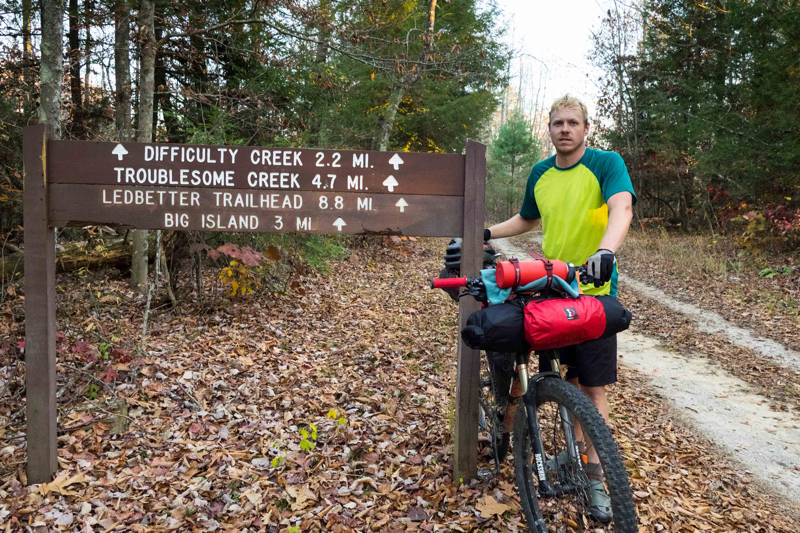
We’d have to plan C to a back-up campsite, with nine miles on gravel roads. On our way, we stopped by Peters Mountain trailhead to inspect what could work as a camp. But with broken glass and trash strewn around a picnic table and outhouse, it looked like a sketchy backwoods hangout. Instead, we zipped down Peters Mountain Road into Rock Creek valley. The temperature plummeted as we descended. We were shivering as we rolled into Bell Farm Horse Camp—locked for the season, but fine for us to use according to the ranger.
This was our first cold season multiday bike trip, after years of milder season rides. We’d come prepared with highly packable layers, shells, puff coats, hats, gloves, and socks. When the long-term forecast announced dropping temps throughout the weekend, I’d called Boberts in a mild panic.
“I have a foot crisis,” I’d blurted, explaining that my increasingly poor circulation had led to near frost-nip situations on recent winter paddling and skiing trips. Extra wool socks no longer cut it.
“You have a foot crisis,” Dr. Boberts expertly diagnosed.
“Thanks, doc. And there’s no magic pill for that? Maybe something that can’t be transported across state lines?”
Boberts suggested shoe covers, so I now had a pair of those, too.
We had a fun night, catching up fireside. We rehydrated with water, dehydrated with whiskey, rehydrated with Mountain House meals. The ground was frozen by the time we called it quits. We were feeling lazy, and what with the season well over, we didn’t string a bear bag. Instead, we hung our food from the lantern post at an adjacent site.
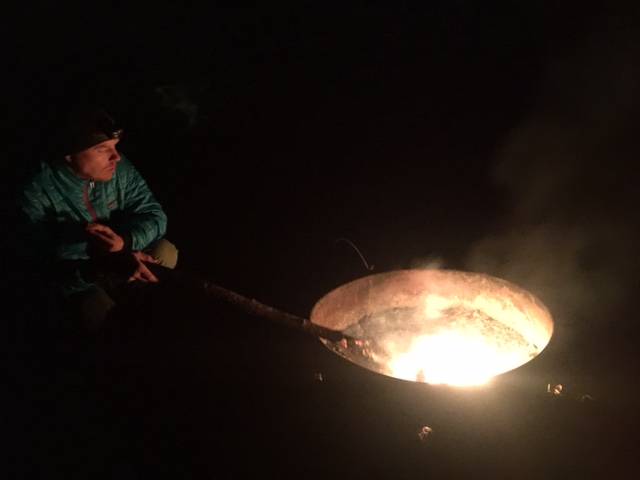
It was around five a.m. when I awoke to the huffing sound of nostrils near my head. Like a curious dog, but louder, deeper, throatier. And that would be a bear. It was probably only feet from my tent. I held still, determined not to startle it and end up with a few new openings in the tent or me. I heard leaves crackle as it moved off, hopefully away from Boberts’ hammock and not toward.
“Boberts!” I whispered. “There’s a bear in our camp!”
“Yeah, no shit,” said Boberts, fully awake.
“We need to make a lot of noise to scare it off,” I said, slightly louder.
“No, we need to be quiet, so it doesn’t come back.”
With increasingly loud voices, we argued about strategies, until the bear became frustrated by our poor interpersonal communication skills and ran off through the bushes.
The next day, we filled water and took off on the gravel road that followed Rock Creek. We passed a few homesteads but more collapsed cabins. Tiny graveyards, with bright plastic flowers offered by gravestones, reminded us of Appalachia’s booms and busts. Our goal was to use our lone full day to loop back on the Kentucky Trail and explore south toward the epic ride. Gravel led to a paved but steep climb. On the desolate ridgetop, one old and small Baptist church stood just down the road from another massive and newer Baptist church.
At the bottom of the hill, we entered a tiny hamlet with a dozen cabins and trailers. Most yards had a handmade sign, with similarly-themed questions, which made the whole town feel like a pop quiz. Things like:
“How will you meet THE END?”
“Can you welcome him into your heart?
“Jesus is coming. Are you ready?
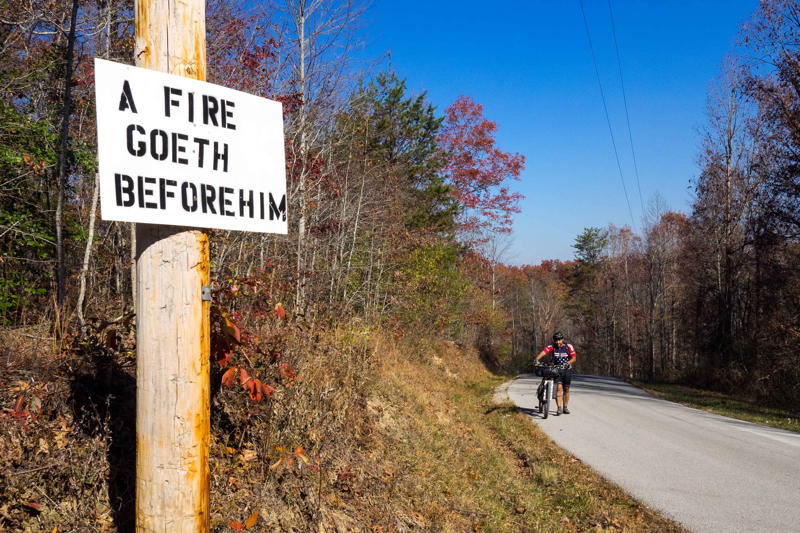
“I forgot,” said Boberts, slapping his forehead. “That’s the one thing we’re not prepared for.”
From Dick Gap trailhead, we rejoined the single-track Kentucky Trail. In some spots, it was steep yet passable. Soon the challenges and contradictions resumed. The forest was lush and gorgeous, but the trail included frequent bone-rattling erosion planks. We passed a remarkable waterfall, but had to descend several cliffs by wooden staircase. We even encountered a ladder over a down tree.
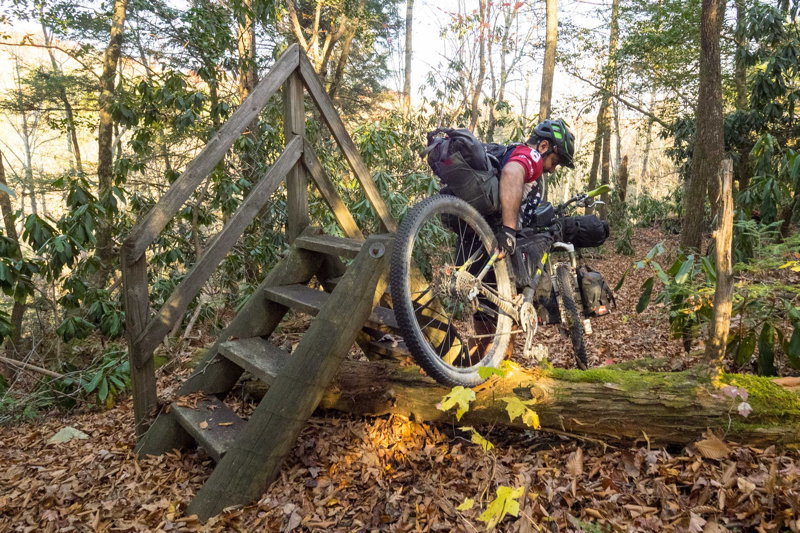
“A real bridge to nowhere,” muttered Boberts as we carried over.
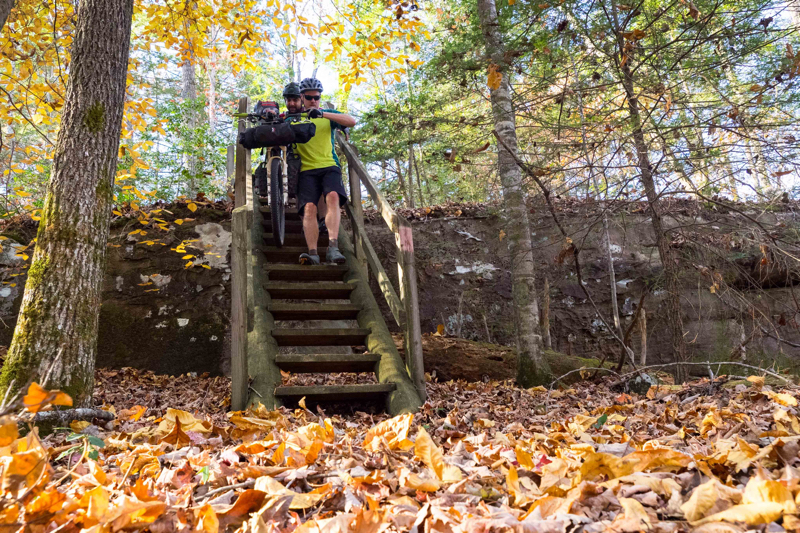
Hoping to replenish water at the promisingly named Big Spring Hollow, we instead found an algae and bug-infested trickle. We climbed to the next creek, but no better. We couldn’t bring ourselves to treat this murky stuff, so now we needed a new plan. The river was hundreds of feet down a mossy cliff face. We were moving only 1-2 miles per hour. Despite temps in the low-50s, we were sucking water down faster than expected due to all the exertion. Thus, backtracking seemed out. We agreed to accept defeat, skip the epic ride, and return to the gravel ridge road. The easier riding would allow us to conserve water. And hopefully we could fill up along the way instead of returning all the way to Rock Creek.
Luckily, the climb to the road was gradual and soon we were on gravel, making good time. We passed a few settlements, but all were either abandoned or fenced-in fortresses, with no trespassing signs. We’d nearly resigned ourselves to returning to Rock Creek, when we passed a cabin with a three-generation family sitting on the porch. When I asked if there was a nearby water source, the grandmother stood up.
“Sure is,” she said warmly, pointing at the ground. “Got water right here.”
She explained they had a well and insisted we fill up in her kitchen, not with the garden hose. We spent a half hour visiting and chatting about our ride thus far. They had no phone, no TV, just a generator and probably a radio—though we didn’t see one. They seemed almost completely untouched by the circus of the 2016 presidential election. I wished we could say the same. Eventually, we pushed on toward an uncertain camp.
Clouds were gathering on the horizon. A stiff and icy headwind picked up, followed by drizzly rain. We squinted as we rode the scenic ridgeline between thick forest and periodic sandstone outcrops. When we passed the less-than-ideal Peters Mountain trailhead we’d spotted the night before, we doubled back. The smart choice was to build camp before the storm hit. Tent and hammock went up, and we rolled bikes into the outhouse. I cleared the kitchen area of broken glass and trash—a final pedal to the shins on a trip that hadn’t gone as hoped.
Temps were in the low thirties by the time we sat down at the picnic table for dinner. Snow flurries fell from a thick black sky. On the road below, truck headlights rolled through the junction and began ascending the sideroad to our clearing. The truck stopped, possibly spotting my headlamp as I burned water on my alcohol stove.
“Got company,” I said.
Boberts glanced around. With cinder block shadows and moonlight glistening off broken bottles, the clearing had all the charm of an impromptu car camp or an Appalachian meth shop.
“Turn your light off,” whispered Boberts.
“Turn yours ON,” I countered. “Let them know we’re here and this space is taken.”
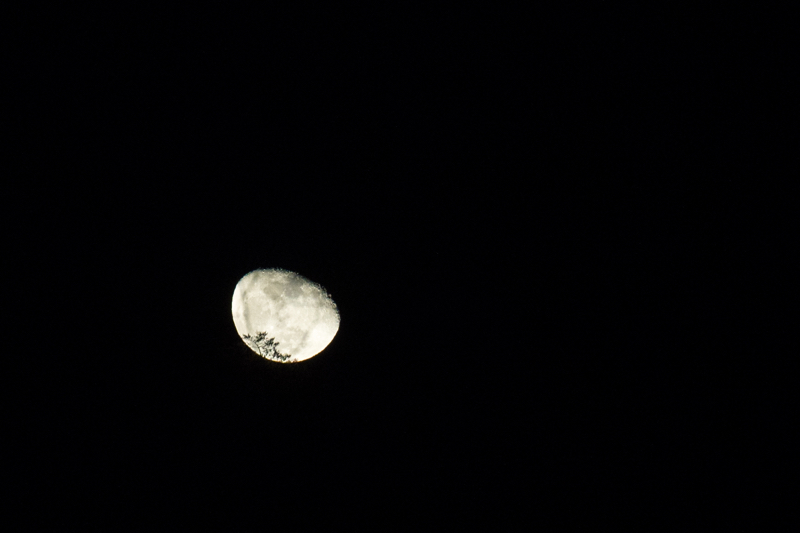
While we argued about strategies, our headlamp beams swung around the clearing in spastic movements. From a distance, they probably looked downright meth-induced. The truck occupants must have become suspicious of our behaviors, because the truck reversed down the sideroad and sped off into the darkness.
Our only remaining challenge was the dropping temperature. Boberts is a burly fella who doesn’t usually get cold, yet also doesn’t like the cold—his nickname isn’t Dr. Boberts Hawaii M.D. without reason. So, he never anticipated wanting an under-quilt for his hammock. I gave him all my extra clothes for insulation. Plus, I told him that if it came to it, we could turn my 1.5-man tent into a 2.5-man emergency shelter by lying straight as boards and holding our breaths all night. I was relieved when Boberts said that wasn’t necessary. And I slept soundly through the night, while Boberts was absolutely miserable and developed his own circulation condition.
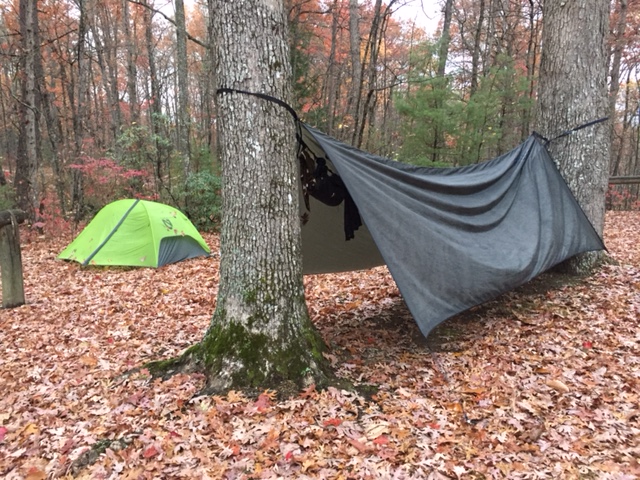
After hot coffee the next morning, we rode out along the Divide Road, plus a series of trails, steeps, and creek crossings. We were pushing up another insane slope, when Boberts offered an unsolicited compliment.
“You know,” he said. “When you’re on your game, you’re really on your game. But—”
“There was a forest fire,” I interrupted. “Should we have just ridden laps around your block a thousand times?”
“Just saying,” said Boberts, with a laugh.
“Well, thanks,” I replied, chuckling. “I mean, I did put a lot of effort into this plan B.”
“Can you imagine what might have happened if you hadn’t?”
We went on like this for a while, so busy joking about lessons learned that neither of us noticed we’d reached the top of our last push. Despite it being a few degrees above freezing, neither of us was cold anymore. And as we rode the remaining miles through a pit of sand—okay, who put that here? Are we being toyed with?—we started talking about where to ride next.
“Some place where we ride more than sixty percent of the time,” said one of us, can’t remember who, while the other said, “Agreed.”
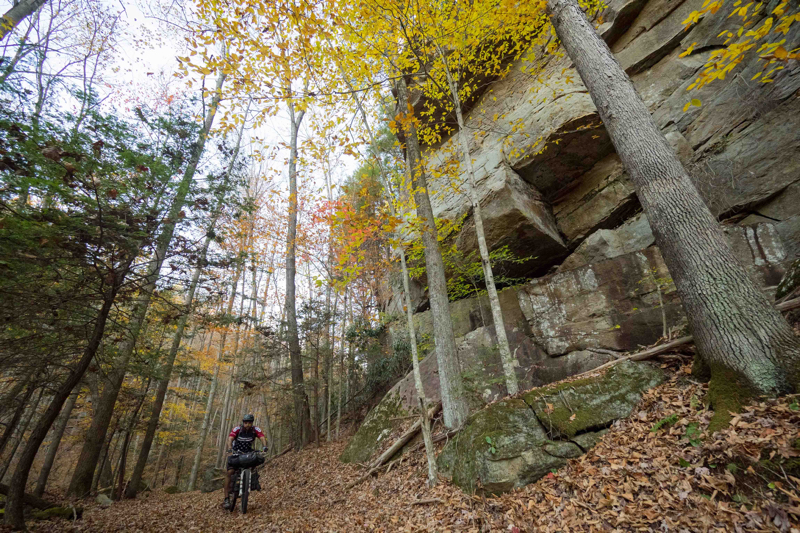
Photos by Boberts Hawaii and California Mike.
Mike Bezemek is a writer and photographer of books and blogs for Adventure Cyclist Magazine, Canoe & Kayak, Falcon Guides, Skyhorse Publishing, and more. Please find links to his work and contact info at mikebezemek.com.
Mike Bezemek is a writer and photographer of books and blogs for Adventure Cyclist Magazine, Canoe & Kayak, Falcon Guides, Skyhorse Publishing, and more. Please find links to his work and contact info at mikebezemek.com.

